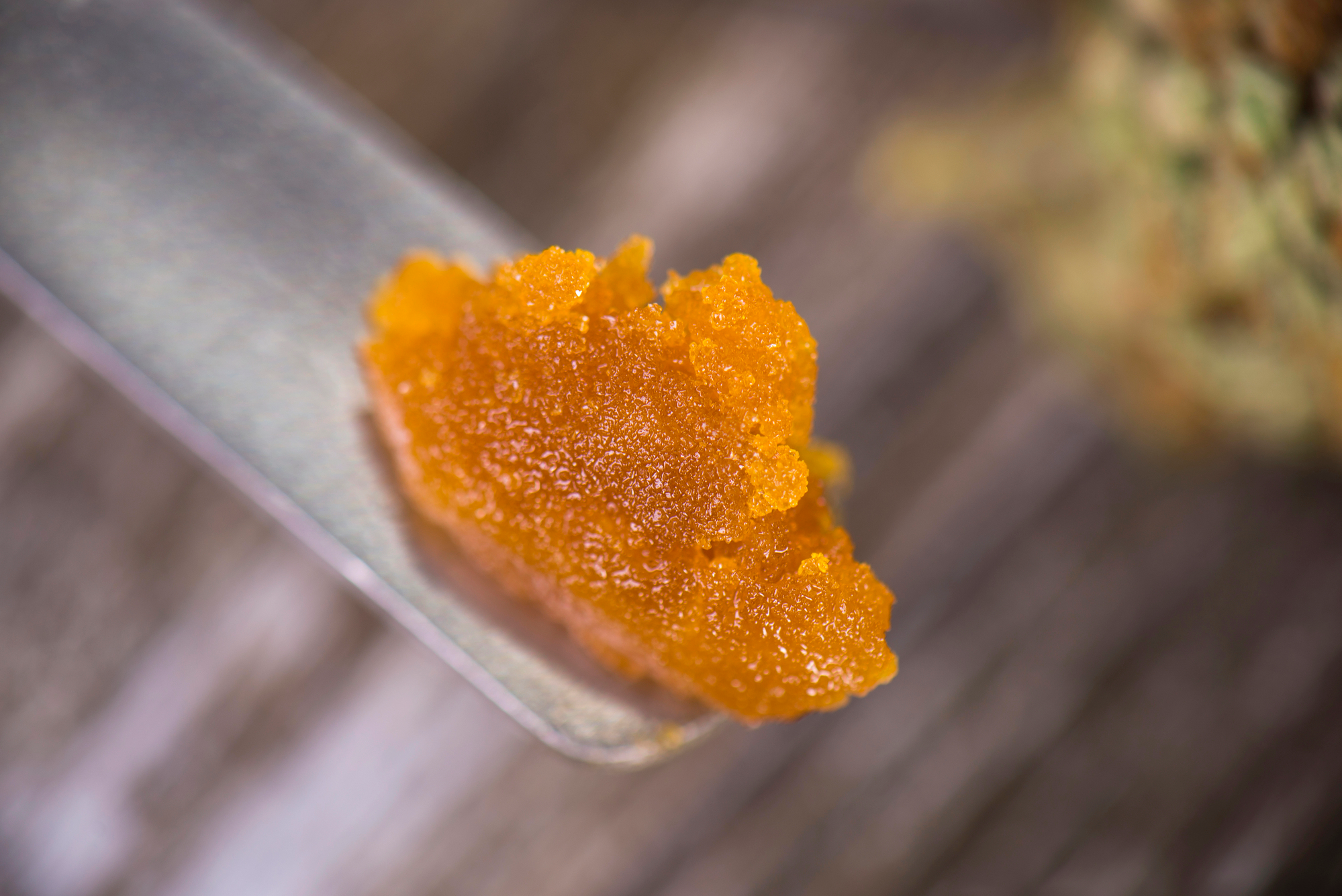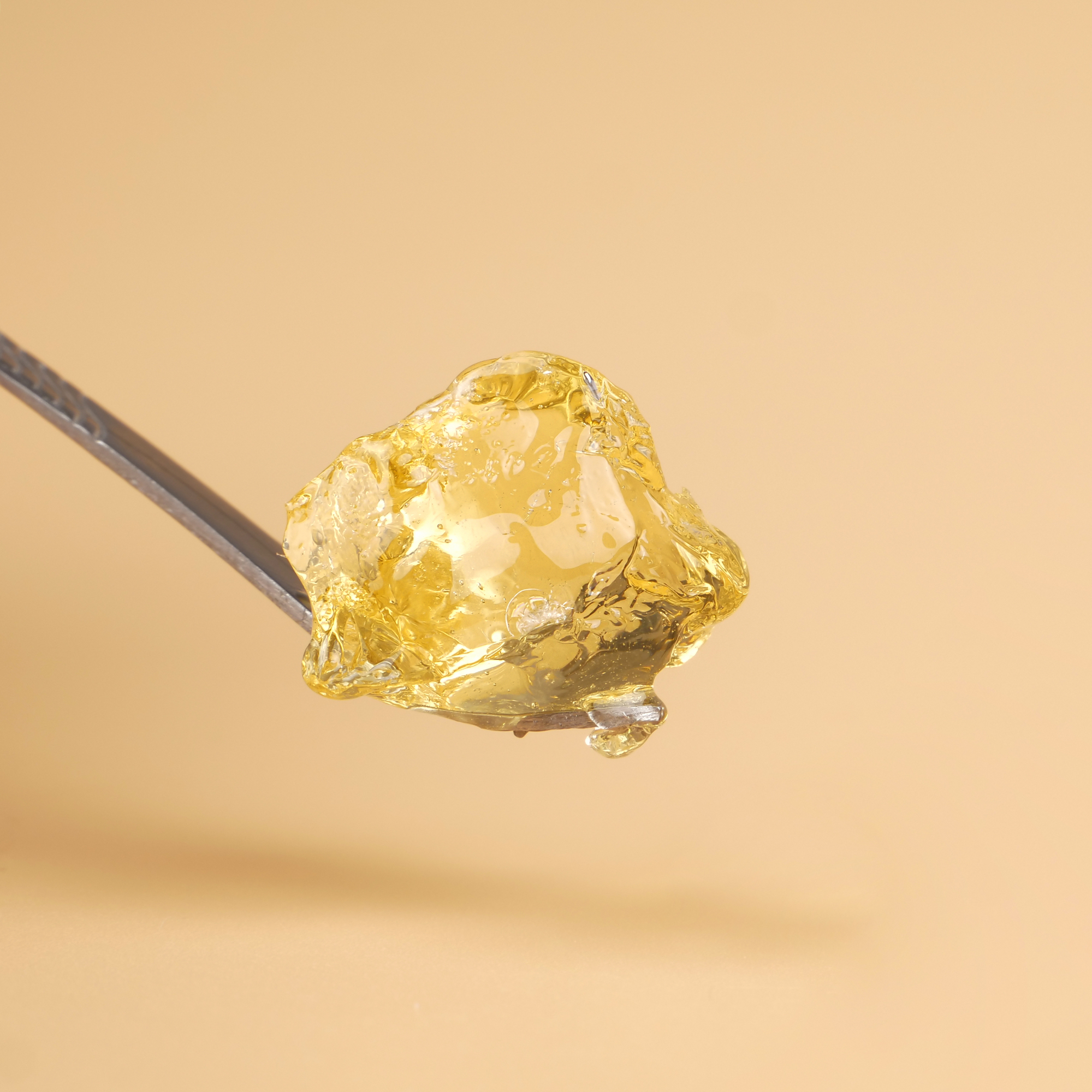

Dabs 101: What Is A Dab?
If you’ve been part of the cannabis community for a while or are just getting started, you may have heard the term “dab” thrown around. But what exactly is a dab?
While some may think of the popular gesture/dance move or even a small amount of butter in cooking, in the world of cannabis, a dab takes on an entirely different meaning. Butane honey oil, a type of cannabis concentrate derived using butane as a solvent, is one of the many forms that dabs can take.
What is a dab?

Dab vs. butane hash oil
Let’s start by defining what a dab is, how to use a dab rig and how it differs from hash.
Dabs/Extracts:
Dabs are concentrated doses of cannabis made by extracting THC and other cannabinoids using a solvent like butane or CO2. These marijuana concentrates, often referred to as wax, shatter, budder, or butane hash oil (BHO), are dark brown or yellow-colored and have high THC levels ranging from 60% to 90%, with some concentrates having even higher concentrations.
Hash:
Hash, or hashish, is a concentrate made by compressing or purifying trichomes, the tiny resin-filled glands on the cannabis plant. Traditional methods include hand-rolling or using sieves.
Defining dabs, cannabis extracts, and hash

Hash is one of the oldest cannabis concentrates and involves compressing trichomes from the cannabis plant to yield a sticky extract. This kind of cannabis product can be hand rolled, or produced with sifting trays and a light heat press. Hash resembles a dark brown/amber paste, rich with cannabinoids, flavonoids, and other non-active compounds found in a cannabis flower.
Plant material is used in various extraction processes to create different types of concentrates, such as live resin, rosin, and bubble hash. The type of plant material, like trim or flower, can significantly affect the quality of the concentrates produced.
Dabs, on the other hand, are a more modern form of cannabis concentrate, known for their potency and diverse textures. There are a number of methods used today to extract cannabis oil, ranging from simplistic and tedious, to fast and complex. Many dabble extracts are refined through various purification and filtration processes that strip the extract of any bitter or toxic compounds found in crude cannabis extract.
Of course, you can attempt to dab traditional cannabis hash, but it may taste a little harsh and leave burnt residue on your piece because of the chlorophyll still present in the hash. Dabbing oils that are more refined, offers a more pleasant and smooth smoke, without ‘chazzing your banger’.
Difference in effects
The primary difference between dabs and hash lies in potency and method of consumption. Dabs are generally much more potent due to the extraction process, providing a stronger, faster onset of effects.
It is important to note the health risks associated with high THC levels in marijuana dabs, including potential contamination with toxic substances and microbial pathogens. Using products from reliable sources and practicing harm reduction strategies can help minimize these health risks.
While hash can be a very heady and euphoric experience, it is slightly less potent than extracts like live resin, distillate, or diamond sauce extracts. While hash may test between 40-65% THC, modern cannabis concentrates test around 70-99.9% THC.
Consuming cannabis with a dab rig tends to intensify the effects of the cannabinoids. The flash vaporization of the dab makes this method more bioavailable, meaning it may feel stronger than a puff from a vape pen or pipe.
What is dabbing?

Origins
The practice of dabbing has roots in the underground culture of cannabis. Almost 20 years ago, the first dabs were being consumed with a hot butter knife and an orange-hot stove burner. This free-basing technique has evolved over time into a more sophisticated practice with the introduction of dab rigs, pens, and other accessory tools.
It has since become a hallmark of high-end cannabis experiences, due to its flavorful and potent properties. But beyond connoisseur satisfaction, dabs offer a unique therapeutic advantage to other cannabis products. However, the use of butane honey oil (BHO) in dabbing is associated with intense withdrawal symptoms, including nervousness, anxiety, irritability, and insomnia.
The onset of a dab is almost instantaneous, as it reaches the blood-brain barrier within seconds after inhaling. This fast-acting relief has proven to be quite helpful due to its antispasmodic effects. Many patients who use cannabis to manage symptoms of Parkensons or Epilepsy find comfort in dabbing, as it provides relief in seconds.
Techniques and tools
Dab Rigs: Glass pipes similar to bongs but designed for concentrates.
Pens: Portable vaporizers specifically designed for dabs.
Automated Tools: Innovations that make dabbing safer and easier, akin to vaping. This includes PID controlled e-nails, heat probes, and all-in-one units like the Puffco Peak
Some of these tools have made dabbing more accessible to medical patients looking to cannabis for relief from chronic illness. All-in-one electronic units have been designed so that consumers do not have to pucker to properly inhale a dab. This has changed the game for individuals suffering from muscular degenerative conditions. It is also crucial to ensure that residual solvents are thoroughly purged from the final product to meet regulations and avoid potential health hazards.
Temperature control
To ensure a safe and smooth experience while dabbing, it is critical to dab at controlled temperatures. Dabbing too hot (over 600 Degrees F) could result in damage to the soft tissue of the throat and lungs. In contrast, dabbing at a safe temperature can enhance both flavor and effects, while also protecting you from an intense coughing fit. Dabbers will often utilize tools such as electronic heating nails, or a timer and heat detecting gun to ensure they are dabbing at their preferred temperature. Additionally, consuming cannabis concentrates can pose health risks, particularly if they are contaminated with toxic substances or microbial pathogens, and it is important to use products from reliable sources to minimize these risks.
Low Temp: 400 - 500 Degrees F
Medium Temp: 550-600 Degrees F
High Temp: 650 - 900 Degrees F
Types of cannabis extracts you can dab

Though you may not want to dab hand rolled hash in your rig, there are many types of cannabis concentrates you can dab. Each type offers a unique texture, flavor profile, and potency, allowing users to choose based on their preferences. Dabs are a concentrated form of cannabis with diverse textures and consistencies.
Shatter
Wax
Crumble
Live Resin
Rosin
Isolates/Crystal
Distillates
Diamonds
Sugar
Sauce
How to dose your dab

Next to temperature, dose size plays the second largest factor in the quality of your dab. Depending on the potency of cannabinoids and terpenes in your extract, you may want a smaller or larger dab. Extracts rich in terpenes like sauce or rosin tend to have lower melting points, meaning the compounds are more volatile when exposed to heat. Consuming terpene-heavy dabs is best at low temperatures below 550 degrees F.
It is always best to start out small and increase your dab portion after getting a feel for how it affects you personally. If you are used to smoking flowers and prefer to dose edibles around 5-10 mg, a giant THCA crystal might not be the best choice for a first dab, as you could be inhaling over 180 mg in one puff. The primary reason individuals consume cannabis, including dabs, is often for its potent effects and rapid onset.
Examples of dab portion sizes:
Small Dab: The size of a grain of rice, or a single lentil
Medium Dab: The size of a sunflower seed, or a thumb tack
Large Dab: The size of a pencil eraser, a breath mint, or a blade of grass
The larger your dab size, the more likely you are to feel strong psychedelic effects when dabbing. This can sometimes lead to an overwhelming experience that may induce dizziness or anxiety. However, dabbing small to medium portion sizes can result in a strong but enjoyable experience for the body and mind.
Are dabs dangerous? Understanding the health risks
When monitoring your dose, dab temperature, and the quality of your extracts well, dabbing can be a very safe and fun experience. In cases where you may take too large or too hot of a dab, there are some risks to be aware of beyond the unpleasant effects of feeling too high.
Excessive dabbing at high temperature can result in chronic respiratory illnesses and may present as a consistent wet cough that gets worse over time. To prevent this ‘butter lung’ effect, it is best to dab at safe temperatures and to take frequent tolerance breaks from cannabis consumption.
Long-term cannabis use of high-potency products can sometimes result in other illnesses such as Cannabinoid Toxicity or Cannabinoid Hyperemesis Syndrome (CHS). These can manifest as severe nausea and vomiting, occasionally requiring medical intervention. Additionally, the use of psychoactive drugs, particularly cannabis concentrates, can pose risks such as psychosis, toxicity, and cannabis dependence.
Understanding these risks and utilizing tools like automated rigs or dab pens may be a safe way to minimize cases of overdose or illness when dabbing.
Dabble in the magic of dabs
Dabbing is a potent and flavorful way to experience cannabis, offering unique advantages for both medicinal and recreational users. However, it’s essential to approach it with caution, especially if you’re new to the practice. The physiologic and psychological effects of using cannabis dabs can include lung injuries, acute and chronic lung impairment, structural brain changes, psychosis, cognitive dysfunction, tachycardia, hypertension, amnesia, hallucinations, end-organ damage, agitation, anxiety, attention deficits, memory impairment, mood alterations, addiction, physical dependence, and withdrawal symptoms.
This comprehensive guide should provide you with a solid understanding of what dabs are, how they differ from other cannabis products, and how to use them safely and effectively.
Whether you’re a seasoned consumer or a curious beginner, dabbing offers a new way to enjoy the myriad benefits of cannabis.











Leave a comment